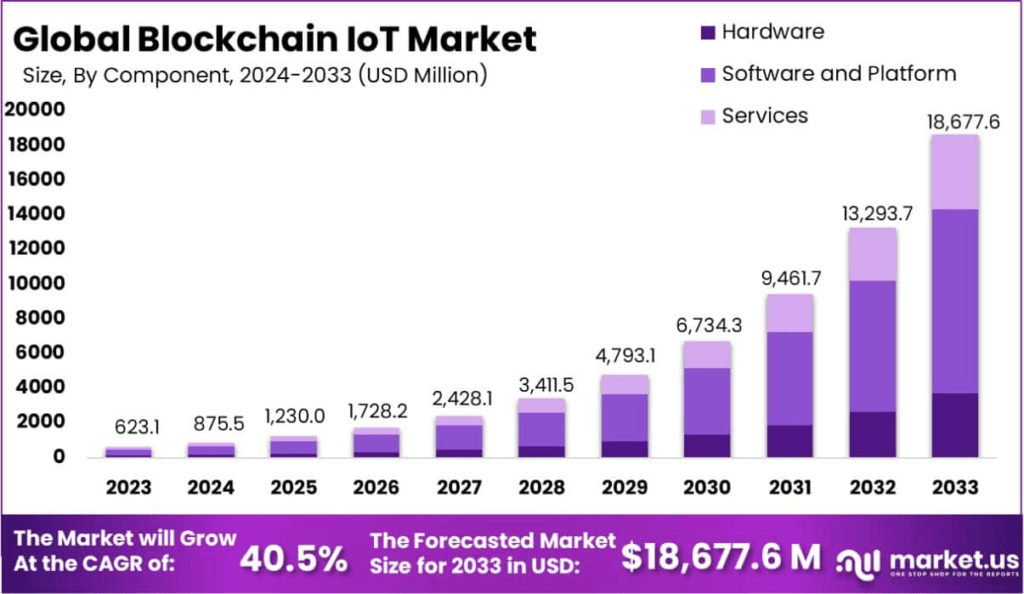Introduction
The Blockchain IoT market is gaining momentum, with a valuation surpassing USD 700 million in 2024 and projected to reach over USD 5 billion by 2030, growing at a CAGR of 40%+. This growth is driven by the need for secure, decentralized data exchanges among IoT devices, addressing issues such as trust, automation, and transparency. The integration of blockchain into IoT networks is transforming data integrity and operational efficiency in industries including manufacturing, energy, logistics, and healthcare. Rising demand for tamper-proof data logging, secure peer-to-peer communication, and smart contract deployment is fueling widespread adoption across enterprises and governments.

Key Takeaways
- Market to grow at over 40% CAGR, surpassing USD 5 billion by 2030
- Blockchain adds a security layer to IoT ecosystems
- Enhances data integrity and transparency in device communication
- Accelerates automation with smart contracts and decentralized apps
- Reduces operational costs through peer-to-peer transactions
- Strengthens trust in multi-party supply chains
- Rapid adoption in energy, logistics, and industrial IoT segments
- Growth supported by rising cyber threats in IoT networks
- Increased collaboration between blockchain developers and IoT vendors
- Governments exploring blockchain IoT in smart city frameworks
Emerging Trends
The Blockchain IoT market is evolving through key trends. Decentralized identity (DID) frameworks are being adopted to authenticate IoT devices. Cross-industry consortia are standardizing protocols to promote interoperability. Edge computing combined with blockchain is enabling real-time, secure device communication. There’s increasing use of blockchain in energy grids for device-level data validation. Startups are leveraging token-based ecosystems to incentivize device interactions. AI is being integrated with blockchain IoT to improve decision-making at the edge. Private and hybrid blockchain architectures are becoming more popular for scalability and compliance. Environmental monitoring and smart infrastructure use cases are driving innovation in this domain.
Use Cases
Blockchain IoT applications are diverse and impactful. In supply chains, it enables end-to-end product traceability. Smart factories use blockchain to record machine data securely for predictive maintenance. In agriculture, IoT sensors linked with blockchain validate crop data for insurance and compliance. Energy providers leverage blockchain to balance decentralized energy transactions in real time. Healthcare uses include patient monitoring devices storing encrypted health data. In logistics, blockchain secures shipment records and reduces fraud. Smart homes integrate blockchain for device control and identity verification. Autonomous vehicles use it to exchange sensor data safely. Environmental agencies monitor air and water quality through blockchain-linked sensors.
Major Challenges
Despite high potential, the Blockchain IoT market faces considerable challenges. Scalability remains a concern as blockchains struggle to handle large IoT data volumes in real time. High latency in consensus mechanisms limits speed-sensitive applications. Integration complexity arises when connecting legacy IoT systems to blockchain networks. Energy consumption, particularly in public blockchains, raises environmental concerns.
There is a lack of unified standards for interoperability across platforms. Security at the device level, such as firmware vulnerabilities, may bypass blockchain protections. Data privacy issues persist with blockchain’s immutable nature. High development and maintenance costs deter small businesses. Regulatory uncertainty adds another layer of risk.
Opportunities
There are significant opportunities within the Blockchain IoT landscape. Advancements in Layer 2 blockchain protocols can alleviate scalability concerns. The rise of 5G and edge computing enhances blockchain IoT performance. Governments investing in digital infrastructure provide momentum for smart city applications. Decentralized energy and mobility networks create demand for real-time secure transactions.
Blockchain-based IoT marketplaces allow monetization of device data. Enterprises can reduce fraud and downtime through automated contract enforcement. Hybrid cloud-blockchain architectures offer both scalability and compliance. Open-source ecosystems drive innovation and lower entry barriers. Collaborations between telecom, tech, and infrastructure players are opening new monetization models for global expansion.
Key Player Analysis
Key players in the Blockchain IoT market include technology providers, telecom operators, cloud platform vendors, and blockchain infrastructure developers. These entities focus on building end-to-end solutions that secure device communication, automate data processing, and enable decentralized governance. Many provide modular platforms that integrate seamlessly with existing IoT ecosystems. Edge security, consensus efficiency, and smart contract automation are primary areas of innovation. These players often collaborate across industries to standardize protocols and support vertical-specific deployments. Investment in R&D, partnerships, and pilot projects drive competitive differentiation. Leaders focus on reducing latency, increasing scalability, and supporting enterprise-grade compliance in regulated sectors.
Conclusion
The Blockchain IoT market represents a transformative convergence of two powerful technologies poised to redefine data security, operational transparency, and decentralized automation. As enterprises and governments seek more resilient and trustworthy systems, the integration of blockchain with IoT offers solutions to long-standing challenges in device communication and data management. Despite technical and regulatory hurdles, continuous innovation and collaboration are enabling scalable, secure, and efficient deployments. The market’s trajectory suggests robust future growth, with cross-industry adoption accelerating. In the coming years, Blockchain IoT will play a pivotal role in shaping smarter, more autonomous, and interconnected digital ecosystems.
The macro analyst desk brings highly sought after financial news based on market analysis, insider news and company filings.
